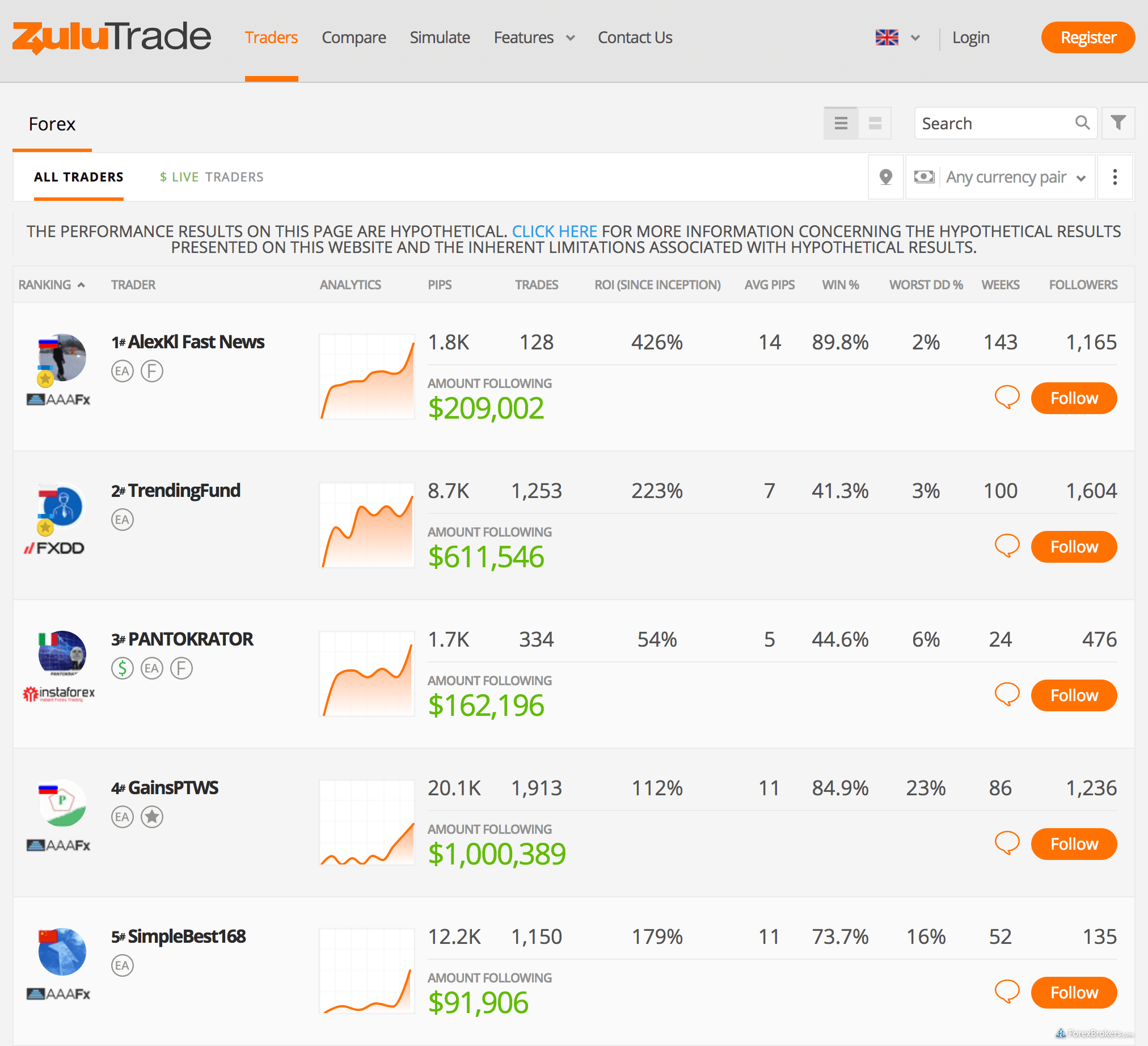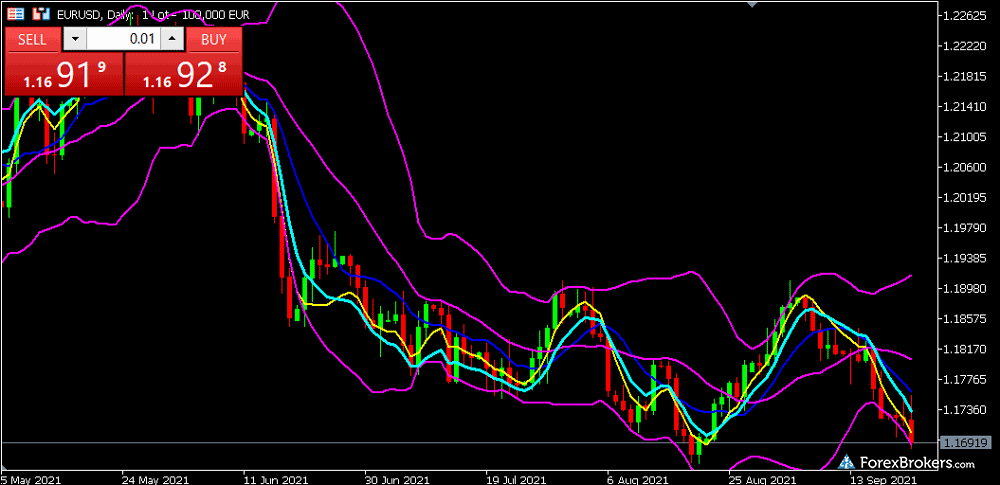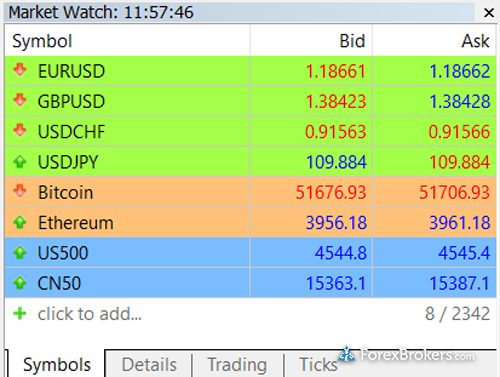Top broker picks for copy trading
Best forex broker for copy trading - eToro
| Company |
Proprietary Platform |
MetaTrader 4 (MT4) |
cTrader |
ZuluTrade |
DupliTrade |
 eToro eToro
|
Yes |
No |
No |
No |
No |
eToro is my top choice for copy trading due to its easy-to-use platform where traders can duplicate the trades of investors on over 2,300 different instruments, including exchange-traded securities, forex, CFDs, and popular cryptocurrencies.
Research and tools: eToro has also significantly improved its education within its Learning Academy and has enhanced its available research, both of which complement its copy trading offering and client experience. The research improvements include the addition of TipRanks and Trading Central as well as client sentiment data.
Native copy trading focus: One of the reasons eToro is consistently ranked in first place for copy trading is in large part due to this being practically its entire focus, compared to nearly all other brokers who only offer copy trading as a secondary platform. As a result, copy trading is deeply ingrained in the eToro experience. The broker’s main innovation is merging self-directed trading and copy trading under a unified trading experience. It is a winning combination and remains eToro’s primary focus.
Social network experience: eToro has a fantastic social network experience, as part of its news feed where traders and popular investors can share and comment on posts within its community. In addition, its CopyPortfolios tool allows you to copy a pre-packaged selection of other popular investors, a nice innovation that helps eToro stand out from other copy trading platform providers.
Popular Investor program and the eToro Club: In order to crowdsource the best traders to share their strategies for others to copy, eToro has a popular investor program that rewards you when you have consistent risk-adjusted returns. The program ranges from its base tier, Cadet, all the way up to its highest tier, Elite, each with increasing perks such as rebates.
Pricing: eToro remains slightly pricier than most of its competitors, despite recently cutting spreads and introducing zero-dollar commissions for U.S. stock trading. However, I feel that the extra cost of marked-up spreads is offset by the fact that you are receiving eToro’s copy trading services for free, as otherwise, you would have to pay for copy trading separately. To learn more, visit my full review of eToro.
Note: Past performance is not an indication of future results. Copy trading does not amount to investment advice. Copy trading takes place in a self-directed account, and your capital is no less at risk. The value of your investments may go up or down.
Best for a variety of platform options - AvaTrade
| Company |
Proprietary Platform |
MetaTrader 4 (MT4) |
cTrader |
ZuluTrade |
DupliTrade |
 AvaTrade AvaTrade
|
Yes |
Yes |
No |
Yes |
Yes |
AvaTrade is a trusted global brand best known for offering traders an extensive selection of trading platforms, including copy trading, alongside access to a wide variety of markets, such as options and - most recently - futures trading.
Well-balanced offering: My testing found AvaTrade to be great for copy trading, competitive for mobile, mostly in line with the industry average for pricing and research, and an outstanding choice for investor education. Experienced active traders may also be interested that more competitive pricing is available at AvaTrade on its Pro account for clients that are designated as Professional traders.
Platform selection for copy trading: Alongside MetaTrader which supports the signals markets for copy trading, AvaTrade offers ZuluTrade and DupliTrade, and recently launched AvaSocial for social trading. The wide variety of platform options is one reason that AvaTrade is a great choice for copy trading.
AvaSocial powered by Pelican: AvaSocial is the latest copy trading platform from AvaTrader. It is developed and powered by Pelican which brings its own network of traders from around the world. Typically when brokers launch a new copy trading platform from scratch it can take many months and even years to amass a large enough network and trading history to provide clients with a substantial list of the best-performing traders to copy. However, that is not the case at AvaSocial since you can scan from among all the expert traders currently in the entire Pelican network. Check out my full review of AvaTrade for the complete rundown.
Best for customization and add-ons - Pepperstone
| Company |
Proprietary Platform |
MetaTrader 4 (MT4) |
cTrader |
ZuluTrade |
DupliTrade |
 Pepperstone Pepperstone
|
Yes |
Yes |
Yes |
No |
Yes |
Pepperstone has long been a provider of copy trading platforms from popular third-party developers and recently launched its own branded version powered by Pelican.
Pricing flexibility and add-ons: What helps make Pepperstone a great choice for copy trading is its vast selection of copy trading platforms and the ability to use either its spread-only standard account or commission-based Razor account across all its platforms. Each platform also comes with a plethora of third-party add-ons at Pepperstone, enhancing the available features beyond the vanilla offering of many other brokers.
Copy trading platform selection: Pepperstone’s dual offering of Signal Start for MetaTrader and DupliTrade for cTrader is a great fit for copy traders and algorithmic traders alike. In addition, cTrader also has its own native copy trading (although I am not a fan of it), just as MetaTrader has the signals market. In addition to support for algorithmic trading, Copy Trading by Pepperstone was recently launched following its partnership with Pelican. Overall, Copy Trading by Pepperstone would be my top choice at Pepperstone when looking to copy trade, simply because of the size of the Pelican network that you can access to analyze other traders to copy.
These factors all contributed to Pepperstone receiving Best-in-Class honors for our MetaTrader, Algo Trading, and Copy Trading categories in our 2025 Annual Awards. That said, while all of these options are fantastic for power users and those who wish to have the flexibility of deep customizability, Pepperstone's lack of competitive educational resources may not make it the best fit for beginner traders trying to learn how to use these tools. Read more at my in-depth review of Pepperstone.
Forex copy trading platforms comparison
FAQs
What is copy trading?
Copy trading is a form of trading where you automatically copy trades placed by another investor in real-time. It’s also known as social trading or mirror trading, and it’s become especially popular in forex markets. Rather than placing trades yourself, you choose experienced traders, also called signal providers, to follow. When they trade, your account mirrors their moves based on your selected risk and capital allocation settings.
What makes copy trading appealing is its accessibility. Even if you’re new to forex, you can copy trades from skilled traders and build a diversified strategy without needing to master every chart or indicator. Most copy trading platforms make this process seamless by offering performance analytics, risk controls, and social features to help you find and follow top-performing traders.
While the concept is simple, choosing the right copy trading broker, and the right traders to follow, makes all the difference. That’s why I evaluate each platform not just on features, but on the quality of their signal providers, regulatory safeguards, and the transparency of their performance data.
Is copy trading legal?
Copy trading is legal in most countries, as long as the broker itself is properly regulated. When investing in financial markets through a regulated broker, there are procedures in place during the account opening process that should ensure it is legal for you to trade (depending on your country of residence).
For example, copy trading is fully legal in the U.S. – provided that your broker is properly regulated by either the Commodity Futures Trading Commission (CFTC) in the case of forex or the Securities and Exchange Commission (SEC) for stocks. For cryptocurrency copy trading, your broker must be a registered Money Services Business (MSB) and licensed by FinCEN. In legal terms, copy trading is typically treated as a self-directed account.
Before copy trading existed, a power of attorney form was required to authorize a fund manager to trade on your behalf. Today, individual investors agree to a Letter of Direction (LoD), which is a form that authorizes the broker to copy the trades of other traders automatically based on your explicit instruction.
Fun fact: The LoD (which is now incorporated in each platform’s terms and conditions) was a crucial piece of the innovation that helped legalize copy trading in the U.S., making it largely indistinguishable from a regular self-directed brokerage account. That said, in certain countries, there are still restrictions. In the U.K., for example, additional money-management licenses are required for copy trading.
mapLooking for a copy trading broker in the U.S.?
Check out my guide to the best forex brokers in the U.S. to learn about legal forex trading for U.S. residents, and to see my picks for the best U.S. forex brokers that are regulated for forex trading.
How do you copy trade?
If you want to start copy trading, your first step will be to choose a copy trading platform. Copy trading platforms allow users to automatically copy trades in real-time using individually customized account settings and platform tools. Next, you’ll need to choose a trader to copy. People that make their trades available to be copied in real-time are known as signal providers. Once you’ve chosen a signal provider, you’ll need to decide to what degree you want to copy the signal provider, and how much capital to allocate.
cell_towerPro tip:
The best signal providers typically have a large following, an established track record of performance (i.e., history of monthly trading results), consistent risk-adjusted returns, and above-average overall results. That said, the past performance of any provider is not a guarantee of future results.
How to start copy trading, in 7 steps:
- Compare the performance rankings and statistics of a variety of signal providers.
- Select a signal provider that complements your own trading goals and risk tolerance.
- Determine how much of your account balance to allocate towards copying the provider’s trades.
- Fine-tune your risk management settings and consider whether you’ll copy the provider’s existing open positions, or only new positions moving forward.
- Once you are comfortable with the settings you have configured, click to copy trade the traders you have decided to follow.
- Monitor the performance of your trading account as often as needed, depending on the frequency of trades established in your copy trading account.
- Adjust your parameters and subscriptions as conditions change (such as signal provider performance, or your own market expectations.
How to put together a copy trading strategy
Here are my top 5 copy trading tips:
1. Look beyond a signal provider's absolute returns. It’s impossible to predict market movements 100% of the time, so you should seek out traders that are statistically consistent.
2. Review a wide variety of statistics and metrics when analyzing the performance of a signal provider. Analyze data points such as average profit and loss, number of trades placed, and average trade duration.
3. Find the right balance of diversification for your trading goals. Copy trading can give you the ability to incorporate a variety of trading styles and tradeable markets within your investment portfolio.
4. Always consider the time horizon (or, expected duration) of your investment when copying another trader. Even if you’ve analyzed the signal provider’s historical performance and found it to be consistent, keep in mind that their investment strategy may vary day-to-day in frequency and/or volume.
5. Familiarize yourself with your copy trading platform's settings for managing risk. Copy trading is not without risk. It’s important to customize your limits and/or thresholds for risk management purposes. For example, you can customize the amount of capital at risk for each signal provider that you are copying.
What is an example of copy trading?
Once you’ve decided which traders you want to copy from within the copy trading platform, you’ll allocate a portion of your account balances towards each trader (or, signal provider) to enable copy trading. For example, if you are copying a trader who buys 100,000 units of the EUR/USD currency, you will see the same proportionally-sized trade in your account – depending on how much you allocate. The trade size in your account may be smaller or larger, depending on how you configured your account when initially subscribing to copy each investor.
Pro tip: Once you find one or more traders you wish to copy from within a copy trading platform, you will need to decide whether you want to only take on any new trades they establish, or immediately copy any of their pre-existing positions that may already be open. There may be additional parameters that you can configure — such as the maximum amount of risk you are willing to take for each trader you copy — and other controls that may affect how you manage your account when copy trading (these can vary depending on the copy trading platform you use).
Besides choosing a trader with good historical results, it's important to look at the performance statistics for each system, such as the amount of risk taken (maximum drawdown) and average trade size, duration, and frequency of trades. Some investors select more than one strategy, but having enough capital and choosing the right risk parameters (if any) is crucial when you copy trade forex strategies. Remember, copy trading is risky. Never invest more money than you are willing to lose.

Is copy trading good for beginners?
Copy trading can be good for beginners, provided they learn the basics and approach copy trading the same way they would any other self-directed trading account. Beginners should always start small before trading more seriously with larger amounts, and it’s always wise to learn how to use the software with a demo account before diving straight into live trading of any kind.
It's important to note that copy trading still requires active account management — it's not a quick fix or an easy way to make money. Copy trading should be thought of as a way to complement your portfolio and existing trading tool arsenal.
Whether or not copy trading is a good idea for you will depend on your preferences, trading goals, and risk tolerance. You'll need to specify various risk/reward parameters and maximum drawdown thresholds and decide which providers to copy (if any).
Beginners should analyze all available performance metrics when deciding whether to copy a particular signal provider. Understanding a given signal provider’s risk tolerance is just as important as measuring their average profits or their overall results. It’s also important to look at a signal provider’s trading volume and frequency, and to decide whether their style of trading would be suitable for your own account balance, profit goals, and risk tolerance.
Remember: Copy trading is not a replacement for self-directed trading, and should not be thought of as a passive investment or managed account.
Our testing
Why you should trust us
Steven Hatzakis is a well-known finance writer, with 25+ years of experience in the foreign exchange and financial markets. He is the Global Director of Online Broker Research for Reink Media Group, leading research efforts for ForexBrokers.com since 2016. Steven is an expert writer and researcher who has published over 1,000 articles covering the foreign exchange markets and cryptocurrency industries. He has served as a registered commodity futures representative for domestic and internationally-regulated brokerages. Steven holds a Series III license in the US as a Commodity Trading Advisor (CTA).
All content on ForexBrokers.com is handwritten by a writer, fact-checked by a member of our research team, and edited and published by an editor. Our ratings, rankings, and opinions are entirely our own, and the result of our extensive research and decades of collective experience covering the forex industry.
Ultimately, our rigorous data validation process yields an error rate of less than .1% each year, providing site visitors with quality data they can trust. Click here to learn more about how we test.
How we tested
At ForexBrokers.com, our online broker reviews are based on our collected quantitative data as well as the observations and qualified opinions of our expert researchers. Each year we publish tens of thousands of words of research on the top forex brokers and monitor dozens of international regulator agencies (read more about how we calculate Trust Score here).
Mobile testing is conducted on modern devices that run the most up-to-date operating systems available:
- For Apple, we use MacBook Pro laptops running macOS 15.3, and the iPhone XS running iOS 18.3.
- For Android, we use the Samsung Galaxy S20 and Samsung Galaxy S23 Ultra devices running Android OS 15.
All websites and web-based platforms are tested using the latest version of the Google Chrome browser.
Our researchers thoroughly test a wide range of key features, such as the availability and quality of watch lists, mobile charting, real-time and streaming quotes, and educational resources – among other important variables. We also evaluate the overall design of the mobile experience, and look for a fluid user experience moving between mobile and desktop platforms.
 eToro
eToro
 AvaTrade
AvaTrade
 Pepperstone
Pepperstone
 Vantage
Vantage
 IC Markets
IC Markets
 Tickmill
Tickmill
 FXCM
FXCM



























